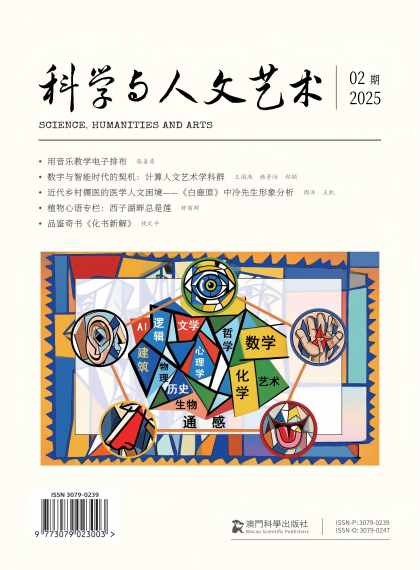
Opportunities in the Digital and Intelligent Era: Computational Humanities and Arts Disciplines
一、导论
进入21世纪,数据的不断增加和计算方法的巨大进步,不仅影响了日常生活,还影响了科学和人文研究的方式[1]。对于社会科学(Social Science)而言,数字化与智能化转型无疑为社会科学的发展注入新动力,毕竟社会科学自诞生伊始便与案例研究和数字分析等实证方法紧密相连。而对于注重思辨性和质化研究的人文科学(Humanities)而言,数字化发展确实对其产生了影响[2]。
在此背景下,2018年,教育部印发《高等学校人工智能创新行动计划》,明确提出了“人工智能+X”复合专业培养新模式,并要求建设“人工智能+X”复合特色专业。随后在2020年,教育部发布了《新文科建设宣言》,强调新文科应紧跟科技革命和产业变革的趋势,积极促进人工智能、大数据等现代信息技术与传统文科专业的深度融合。特别是2023年以来,Chat GPT、DeepSeek等人工智能大模型的快速迭代,使得AI技术协助人文艺术的创作和研究具有了非常广阔的应用前景。
世界各国也陆续成立数字人文研究机构,开展数字人文项目,如国际数字人文组织联盟,旨在促进人文学科领域科研和教学的发展;还有哈佛大学地理分析研究中心、英国伦敦大学学院高级空间分析中心、日本立命馆大学日本艺术文化数字人文中心等依托高校或研究所成立的数字人文研究中心。中国人民大学和苏州大学也相继成立数字人文研究中心,为研究人员提供强大的数据支撑和高效的交流合作平台,从而有力地推动新技术驱动下的人文学术实践向更深层次发展。一些高等教育机构正在为学生提供计算与人文相结合的跨学科课程,如斯坦福大学的CS+X联合专业和维拉诺瓦大学试行的联合模式[3]。近几年中国教育部门也正尝试构建人文学科的跨学科教育新模式。
数据与智能时代的强劲动因,必将深刻推动文学、历史、哲学、艺术等人文学科发生深层次的转型与全面变革。传统研究范式、工具、方法和视野即将面临拓展,计算人文艺术学科群悄然而生,人文科学的发展迎来了新契机。
二、概念辨析及演进
作为人文科学与数字技术动态对话的结果[4],在研究中常见“人文计算”(Humanities Computing)和“数字人文”(Digital Humanities)这两个概念。究其历史,人文计算的概念提出要比数字人文提早约半个世纪。
1. 人文计算的诞生
1946年,世界上第一台通用电子计算机ENIAC的诞生,标志着电子计算机时代的到来。ENIAC由约翰·冯·诺依曼(John von Neumann)、艾达·洛夫莱斯(Ada Lovelace)等人提出的理论为基础,旨在满足美国军方对炮弹弹道计算的需求。这台计算机由17468个真空管组成,重达30吨,每秒可进行5000次加法和357次乘法运算。ENIAC的出现不仅改变了人类处理信息的方式,也为后续计算机技术的发展奠定了基础,从而为利用计算机实现自然语言翻译自动化提供了可能性,人文计算正是在这一基础上产生的。人文计算是将信息及计算技术应用于人文科学领域开展交叉研究的一种研究方法,重点在于开发工具,使研究对象数据化,进而使用工具对数据化后的对象进行研究,为相关学科带来更具挑战性的新问题以及思考旧问题的新方式[5]。
意大利学者罗伯托·布萨(Roberto Busa)是人文科学研究中计算机技术应用的先驱,他自1949年开始与IBM合作,致力于《托马斯著作索引》的编纂,开创了利用计算机技术研究历史文化的先河[6]。1949年,他在纽约IBM公司进行了语言学自动化实验,该实验标志着数字人文的开始,并说服了IBM公司总裁托马斯·J·沃森(Thomas J. Watson)基于技术支持,共同研制计算机编辑程序。经过多年努力,布萨终于将存储机读的穿孔卡片系统升级成为计算机磁盘存储系统[7],极大提升了电子编辑的效率,为人文计算以及数字人文的研究开辟了新时代。
随后,各类研究机构逐步建立。1965年,比萨大学电子计算中心(the Electronic Calculation Center,CNUCE)成立,受到科学和人文学科的广泛欢迎[8]。1966年约瑟夫·雷宾(Joseph Raben)主编的《计算机与人文学》(Computers and the Humanities)期刊开始发行,这是该领域的第一本专业期刊。七年之后,文学与语言学计算协会成立;1978年,计算机与人文学协会建立[9]。
人文科学计算研究在曲折探索中蹒跚前行。除了布萨之外,其他学者也在探索与之相关的文本和作家作品的个案研究。1968年,有学者在意大利开始使用计算机分析语言数据,并将其作为人文研究和社会科学的一种辅助手段[10]。与此同时,一些实力雄厚的欧洲大学开始为其语言学院配备计算机,用于词典编纂。例如,南锡的一所大学建立了旨在归档储存法语文档资料的“法语宝库”,莱顿大学的荷兰语词汇学研究所也购置了计算机设备,开展词汇学的语料研究[11]。威斯博(R.A.Wisbey)结合此前的剑桥研讨会内容于1971年出版了论文集《文学和语言研究中的计算机:剑桥研讨会论文》,列举了不同学者在研究中应用计算机的具体案例,并详细阐述了计算机在语言教学、词典编纂、文学创作及东方语言分析等相对冷门学科中的广泛应用。总之,在经历了20世纪40年代中期到70年代的起步阶段后,西方的人文科学计算研究进入20世纪80年代到90年代拓展阶段。
2. 从人文计算到数字人文
人文计算是数字人文的前身与基础[12]。随着计算机技术不断提升以及电脑的普及,在20世纪90年代中期,互联网成为学术界的重要媒介[13]。人文计算在20世纪90年代中后期得到快速发展[14],其研究的广度和深度都在持续拓展和延伸,数字化已成为人文研究领域不可逆转且日益显著的发展趋势。经过20世纪50多年的发展以及21世纪20多年的繁荣,研究者们逐渐倾向于使用“数字人文”这一术语来替代“人文计算”,数字人文作为一个新兴的交叉学科,正日益受到广泛的关注和重视。数字人文的诞生为传统人文学科研究注入了科学方法论和科学精神,预示着人文学科的研究将变得越来越便利和高效[15]。
在中国,“数字人文”这一概念较为复杂。首先,西方在人文计算概念之前就有量化研究,而中国人文领域的量化研究起步于20世纪80年代[16]。其次,“Digital Humanities”被译介至华语世界时译法不尽相同,且容易使人忽略其跨学科性、实践性所带来的多样性和复杂性。再者,中文语境中没有类似“人文计算”的前期概念,却有着与西方数字人文相似的历史脉络,这使得学界难以就何为“数字人文”达成共识[17]。尽管数字人文为人文科学研究注入了新的活力和方法,但其发展仍面临挑战,包括缺乏成熟的理论体系构建。当前,数字人文领域正致力于整合跨学科的理论与技术,以形成更为统一和系统的理论框架。此外,可视化技术与方法应用尚不充分,难以满足人文领域研究者差异化需求。
3. 从数字人文到计算人文艺术学科群
面对数字人文在研究过程中面临的挑战,笔者提出“计算人文艺术学科群”(Computational Arts and Humanities)的概念,是指文、史、哲、宗、艺等全体人文学科集体面向数字与计算技术形成的交叉新领域,有的已经融合而有的正在或即将开始。
在概念设置上,依据如下:自然科学、社会科学和人文科学是人类科学体系中的三大科学门类,其中人文科学即“关于人的价值及其精神表现的科学”[18],“主要指以人类的信仰、情感、道德和美感等为研究对象的文科科系的学科,通常包括文学、语言、艺术、历史、哲学等领域”[19]。国内学科划分导致的文、艺分离现象,使得艺术领域时常游离于人文科学范畴之外。鉴于此,笔者在概念界定上创新性地提出了“计算人文艺术学科群”的表述。
计算人文艺术学科群是一个融合了计算技术与人文艺术领域的跨学科概念,该学科群由多个形如“计算X”的子学科组成,其中“X”可以对应于某个具体的人文艺术学科,如计算文学、计算历史学、计算艺术学等。这些子学科通过计算技术的运用,对各自领域内的研究对象和研究问题进行深入地分析和呈现,从而推动人文艺术学科的创新与发展。计算人文艺术学科群具有跨学科性、创新性和实践性特点,可以看作是数字人文在学科构建上的进一步发展和细化,更注重构建一个完整的学科体系,并强调不同子学科之间的交叉与融合。
相较于数字人文侧重于数字技术在人文研究方法上的革新,计算人文艺术学科群则聚焦于学科群体的构建及跨学科合作的推进,侧重于通过计算技术来深入分析和呈现人文艺术领域的研究对象和问题,注重技术的具体应用和成果转化,其研究成果可直接应用于文化产品和服务的创新。
三、计算人文艺术学科群的研究领域
在具体研究领域,计算人文艺术学科群包括计算文学(Computational Literature)、计算艺术学(Computational Art)、计算历史学(Computational History)、计算哲学与伦理学(Computational Philosophy and Ethics)等新兴领域的发展,形成了深远而巨大的学科集群转变。在排山倒海的数字与智能化发展趋势下,没有哪一个学科能够始终将技术拒之门外,融合意味着人文学科的生机和发展。
自2008年以来,中国艺术人文领域国际论文数量呈现井喷式增长,涉及的学科类别高达50多个,这一趋势与全球范围内人文艺术领域相关国际文献数量的快速增长相一致[20]。这也暗示了计算人文艺术的典型跨学科特征,对主要相关领域的国际研究进展情况综述如下。
1. 计算文学
在文学研究中,通过获取、编码和分析海量数字文本,可以确定特定作者的文体特征,并用于作者识别、词汇研究、内容和主题分析等[21]。典型研究为2011年发表在Science上的封面文章,该研究使用谷歌词频分析工具Ngram Viewer在所有谷歌图书目录中搜索关键词,以揭示历史图书中的词语及文化演变过程[22]。“Google”提供的这一应用基于近年西方一门新的学术“文化组学(culturomics)”,“culturomics”是“文化”与“基因组学”两个词的合并,其宗旨在于定量分析文本来揭示人类行为和文化发展的趋势[23]。
文学研究中,数字技术推动了文学领域内外合作的深化与数据的高效共享[24]。文学研究长期以来常被自然科学领域质疑其客观性和准确性方面的不足[25]。实际上,分析文学作品的定量方法已经存在多年,中国近代文史学界已经有学者引用计量统计的分析方法来进行文史研究,如胡阿祥以魏晋时代文学家和文学作品的多寡为主要指标探讨文学发展的地区差异[26]。量化统计方法得以广泛应用,主要归因于文史数据的大规模数字化以及信息科技工具为研究提供的便捷性[27-28]。
在近年计算人文的实践中,古籍数字化的成果和数据库的建设有助于推动人文学科的科学化发展[29],学者可以采用数字工具和计算方法从新的角度探索新问题[30]。例如斯蒂斯·汤普森主张将所有文学分析成一种门捷列夫式的主题表[31];还可以将卷积神经网络用于数字人文古籍汉字的元数据加工,将古籍汉字识别问题转换为卷积神经网络的分类问题,从而提高古籍资源的研究效率[32]。
尤为值得关注的是,古籍类数据库的功能绝不应仅仅局限于提供检索便利,而应深入挖掘其作为“数据宝库”的潜在价值,从而加速实现从“数字化存储”到“数据化应用”的深刻转变。在纵向研究中,分析大型文本(特别是数字化书籍)的时间序列,可以发现几个世纪以来文化变迁的宏观模式,有望提供一种定量和数据驱动的工具来研究文化和社会[33-35]。与此同时,数字分析还有助于开发新方法和数据模型[36],如计算文学研究项目MiMo Text,其理念是从书目、学术出版物和第一手资料中提取和文学史有关的陈述,以建立一个共享的文学史知识网络[37];再如计算文学工具包RiTa是一套开源组件、教程和示例,可为创意写作实践提供支持[38]。
2. 计算艺术学
在计算艺术实践中,计算机既被用作为艺术的产生提供媒介的设备(“计算机作为艺术”),又在创作艺术的过程中积极充当助手(“计算机作为艺术家的助手”)[39]。20世纪60年代末至今,计算机艺术的发展为当代艺术发展、艺术学研究范式转变、内涵显性化和知识创造皆提供了新思路[40]。
不同于文学和哲学作品,艺术作品多以图像、影像、声音等形式呈现,鉴于图像检索原理的复杂性,如何高效地采集并分类存储非文字资源,成为了一个亟待解决的问题。Montaina等人使用临床多层X射线断层扫描技术对罗马圣卢卡国家学院美术馆(Accademia di Belle Arti di Roma)中17世纪的版画进行处理,从而对所用木材、面板状况等结构特征进行了阐释[41]。Zhang等人借助模糊聚类算法对中国人文画进行图像分割,实现了有效电子化、数字化转换和保存,比传统扫描方式更能保存文人画的艺术特色[42]。图像信息采集技术不仅能将画面转化为电子形式,更能精准还原原作的笔触与纸张质感,从而显著提升了艺术作品数字化的精确度和真实感。除了物质性的艺术品,音乐可视化、动作捕捉等技术使得非物质性的表演艺术也能够以电子化形式储存[43]。
计算艺术学的研究视角进一步扩大,计算艺术研究能够将不同地区的艺术作品进行横向对比分析,也能够对纵向跨越数百甚至上千年的艺术作品进行时序规律挖掘。王国燕教授的研究团队通过计算艺术学分析,揭示了自唐代以来1400年间中国山水画中留白区域的变化趋势,研究结果发表于国际顶级期刊Leonardo上[44]。Fan等学者通过提取和计算绘画的28种构图特征,对西方油画与中国水墨画的构图进行了深入比较。研究发现,尽管中西绘画在构图方式、焦点位置和色彩运用等方面存在显著差异,但在视觉平衡与沿对角线构图的趋势上却表现出相似性[45]。Huang等学者运用循环神经网络对花儿民歌歌词进行深入的数据挖掘分析,揭示了其语言特色和文化价值,为保护和传承这一非物质文化遗产提供了创新的视角和方法[46]。总之,现有研究在研究领域、研究层次上都较为丰富,证明了计算艺术学具有良好的研究潜力与发展前景。
随着计算机软硬件技术不断成熟以及艺术理论和方法设计发展迅速,计算机辅助艺术设计已成为当前研究的热门领域,每年都有众多创新性的计算机艺术作品不断涌现。卷积神经网络能够模拟高级动物的视觉系统,以此为基础通过对视觉艺术的识别、分类、评估、转移和创作,日渐完善机器自动生成图像的水平[47-48]。卷积神经网络在风格迁移领域的应用广泛,尤其在生成多样化艺术风格的图像方面表现突出,如Zhang和Kejun合作开发的智能篆刻艺术生成系统,便成功攻克了篆刻制作中的多项技术难题[49]。还有研究探索多风格国画艺术的生成以及水墨画的生成工作,可实现国画花卉的智能创作[50]。此外还有研究构建DeepExaggeration系统来生成夸张的肖像漫画,成功解决了使用卷积神经网络进行几何结构特征提取的困难[51]。
3. 计算历史学
历史学家自古以来就使用数学方法来掌握“大数据”,但是直到二战结束后,对历史的定量研究才开始加快步伐[52],计算历史学研究可以追溯到20世纪60年代初[53]。尽管历史学研究和计算机技术结合的过程并不短暂,但目前历史学家对这种“伙伴”关系的未来发展方向还是存在较大分歧[54]:许多研究人员坚持认为计算方法将改变历史专业,也有研究人员认为这是毫无根据的炒作。总体来看,历史研究中融入计算方法的目的并非取代传统历史主义研究,而是旨在丰富其内涵并开拓新的研究领域[55]。
计算历史学研究广泛应用数字形式的资料和基于计算机技术的研究工具[56],尤其是在历史评论、历史地理学、心理学史和新闻学(旧期刊和报纸内容的数字分析)中[57]。历史研究高度依赖史料,互联网的应用推动了数据库技术在图书信息管理领域的普及,为包括历史文献在内的信息管理构建了成熟的软件和解决方案。其中,较为著名的例子是“美国记忆”(American Memory)项目,该项目由美国国会图书馆资助,自1990年起开始实施。它选择并数字化复制了对研究美国历史和文化具有重要意义的收藏品,如文件、照片、胶片等,总数超过700万件,并通过互联网向全球用户免费提供。此外,该项目还致力于提高检索效率和科研成果共享,以期通过大范围的科研协作提高科研效率[58]。中国相关组织也在利用知识组织和规范控制方法重组历史地理数据,实现数据开放应用的目标,代表性研究方向包括空间历史数据的管理与可视化、古籍的数字化开发应用等[59-61]。同时,计算历史学研究可以将不同数据置于同一时空维度下,分析历史要素在时间和空间序列变化中的相互关系[62],那些以往被忽略的历史趋势和微妙变化,有望通过计算历史学的研究方法得以揭示和呈现,从而与传统研究方法互补[63]。在知识组织的层面上,知识序化功能如同一座桥梁,将原本零散分布的史料连接成结构化的知识体系,如在历史写作方法上,有研究基于英语维基百科和大英百科全书的文章,对专家和众包的写作方式进行定量比较,将时间分析与对两个语料库的词汇分析相结合,得出不同的史学观点[64-65]。在知识关联层面,研究集中于构建知识图谱,有助于历史档案资源高效利用和呈现,并实现语义关联与可视化展示[66]。在知识发现层面,研究主要聚焦于通过知识图谱进行多维度的细粒度知识发现。知识图谱运用图模型详尽地描绘知识间的关系,并配备了诸如文物实体关系抽取、命名实体识别等前沿的知识挖掘算法,从而构建了如“中国十大传世名画”这样的知识图谱信息[67]。
4. 计算哲学与伦理学
计算哲学是通过计算技术挖掘哲学和伦理见解[68-69]。“计算”不再是一个数学概念,而上升为极为普适的哲学范畴,成为人们认识事物、研究问题的一种新视角,将对21世纪的自然观、生命观、科学观和科学方法论产生重大影响[70]。
计算机实验有助于解决复杂的哲学和伦理问题[71],如利用人工智能和认知科学工具,可测试以前仅以抽象术语构想的概念和想法[72]。计算机模拟模型正在对伦理和政治哲学、语言哲学和科学伦理产生实质性的影响,以至于Mayo-Wilson 和 Zollman认为建模和计算机模拟应该被视为核心哲学方法,一是因为在实现某些哲学目标方面,模拟优于思想实验;二是因为设计和编码计算模型会形成良好的哲学思维习惯[73]。
计算哲学与伦理学的应用前景非常广阔,发表于Nature杂志的一项著名的道德机器实验,通过收集不同地区人们的数据来部署道德机器,用以探索自动驾驶汽车所面临的道德困境,其结果有助于制定社会可接受的机器伦理原则[74];还有学者认为哲学家不仅要建立自己的模型,还要通过思考该方法在哲学和科学中的应用来为计算建模做出贡献[75],由此可见,计算哲学与伦理学的社会价值正在不断受到学者们的关注和重视。
四、对计算人文艺术研究的反思
信息与计算机技术在社会人文艺术研究领域的融合,是数字智能时代不可逆转的大势所趋。计算人文艺术领域作为一个新的方向,仍有不完善之处。
1. “技术粗、结论浅”的困境消解
首先,计算人文艺术研究可能会存在技术壁垒。不同技术平台的操作性问题,可能限制计算人文艺术学科群的技术应用和创新。突出表现是研究者的技术水平较粗浅,以文学研究为例,分析文学作品的定量方法由于其技术的复杂性壁垒,研究人员往往难以有效驾驭[76],研究人员普遍缺乏相关技术基础及系统培训,还需极大耐心和毅力以克服各种机器故障[77]。因此,应重视计算人文艺术领域研究人员数字素养的提升[78]。可以为研究人员提供丰富的跨学科培训机会,使他们能够全面掌握其他相关领域的知识与技能;同时,也应积极促进教师间的跨学科交流与合作,比如共同申请研究项目,以推动学术创新。
其次,大量已有成果表现为浅层描述性分析,研究不够深入。截至目前,数字人文研究的众多项目尚未能推翻传统意义上的预设,也未产生全新的叙述方式,它们主要是在量化分析方面对已知内容进行了确认[79]。例如Google Ngram Viewer工具的开发虽然可为大批历史文化研究提供可供直观表达的基本结论[80],却被诟病为“说明了真理而非发现真理”[81]。总之,研究目标是通过工具来解决复杂的问题,而不应仅仅停留在浅层分析。正如罗伯托·布萨所说,技术的作用不仅仅是减少人类的工作和时间,而是提高研究的质量、深度和范围。
再者,信息技术领域的发展日新月异,然而计算人文艺术学科群在技术应用方面往往滞后于技术的发展,技术更新带来的成本问题也可能对学科群的发展构成障碍。当前,中国的计算人文艺术研究领域存在一些问题:一方面,对理论的探讨远多于实证研究,真正采用数字人文方法的研究项目十分稀少;另一方面,统计方法与模型设计的原创性不足[82]。因此,及时跟进新技术,是计算人文艺术研究亟须解决的问题。
2. 定量研究方法的分歧弥合
首先是定量研究方法的适用性问题。定量研究方法“严谨”、“纪律”和“系统”作为一种理性的启蒙精神在19世纪虽然被强化,进入20世纪却引发了哲学和艺术乃至科学界的批评[83]。虽然大数据可能带来的所谓更科学的方法,甚至推动人文学科知识生产的新范式,但人文研究是否会沦为数据处理的附庸也受到质疑,对美国计算机辅助研究在20世纪80年代早期采取定量转向的尖锐批评就是证明[84]。人文艺术学科的研究往往涉及情感、审美、文化等主观因素,这些研究对象或现象具有高度复杂性和多样性,难以通过定量研究方法来准确捕捉和量化。
其次,计算人文艺术研究在具体实施时可能会面临方法论冲突。定量研究强调客观、标准化和可重复的经验观察,往往追求普适性的规律和结论。然而,在计算人文艺术研究中,研究者往往更注重对研究对象的主观理解和解释以及注重对特定情境和个案的深入分析,这与定量研究的客观性和标准化要求存在冲突。并且,对于中国学界而言,西方理论与方法的引进存在一个移植与适应的问题,中国的计算人文艺术研究存在双重障碍,即西方理论与中国语境以及自然科学与人文艺术的双重隔膜[85]。
再者,计算人文艺术研究不能忽视数据获取和处理难度。获取既可靠又有效的量化数据,在人文艺术学科领域内,常常被视为一项极为艰巨的任务。研究对象可能涉及广泛的文化、历史和社会背景,这些数据往往难以通过传统的问卷调查、实验等方法来收集。即使能够收集到数据,数据的处理和分析也可能面临诸多挑战。例如,数据的清洗、整理、编码和统计分析等过程可能需要耗费大量的时间精力,且结果可能受到多种因素的影响和干扰。
3. “技术决定论”的争议化解
“人文计算”阶段传达的一种以工具为中心的本体论,而在“数字人文”一词中,数字作为人文学科的一个形容词,是执行人文学科议程的一种手段[86]。一些学者认为,在计算人文艺术领域,技术的发展是推动学科进步和创新的决定性力量。这些学者着重强调了技术的自主性,认为技术通过其独有的途径,深刻地塑造并影响着人文艺术的内容构成与表现形式。Roberto Busa和Franco Moretti深受“技术决定论”影响,转而信仰解决研究问题的数字工具。然而,另一些学者认为技术虽然重要,但并非决定性因素。他们强调人文艺术的内在价值和独立性,认为技术只是实现这些价值的手段之一,坚守“传统思维”的人文主义者则对数字工具展开猛烈的批判[87]。
在计算人文艺术学科群的构建过程中,需审慎对待并化解围绕‘技术决定论’的诸多争议。在计算人文艺术研究中,人文艺术研究仍然是内核。人文学科的精髓不能被技术所稀释。新工具的研发必须紧密围绕学术的实际需求、核心问题及挑战展开,确保工具服务于问题的解决策略,而非强迫问题迁就工具的既有局限。[1]总之,若学者未能深刻洞察工具使用对研究方法论的潜在影响,其对工具的利用效率将大打折扣,难以触及研究领域的深层本质。
4. 智能技术引发对“后人类”未来的警惕
随着人工智能技术在教育、医疗、交通等领域的广泛应用,其在提高效率、个性化服务等方面取得的显著成果,正在深刻地改变人类的生活方式。这种技术的快速发展有可能引领我们进入一个全新的“后人类”(posthuman)阶段[88]。地球上的居民虽然相互联系但同时也是分裂的,阶级、种族、性别与性取向、年龄和身体状况仍然是构建和管理正常“人性”的重要标志,批判性的后人文学科为后人类时代的“人”提供了一系列不断变化的认知和形态[89]。与其他后理论思潮不同的是,后人类主义,作为一种哲学概念,挑战了对人类本性和存在的传统理解,它认为人类的进化可能并不局限于生物边界,而是可以延伸到技术、文化变革和科学进步。它通过人与非人之间的共生关系重塑了本体论、认识论和伦理学,特别是挑战了传统人文主义以“人”为中心的二元论思考方式[90]。
“后人类”是一个前瞻性的反思概念,从中折射出的是面向未来的不同态度,福山(Francis Fukuyama)警惕生物技术的挑战,提出了捍卫人性的保守主义方案,而斯蒂格勒(Bernad Stiegler)则认为技术是人类的义肢性存在,主张在技术时代中寻找人类的根源与出路[91]。有学者担心将计算机带入实践之中,这会是“后人类”历史阶段出现的一个症候,而“后人类”是由技术和资本所控制的[92]。因此在计算人文艺术研究中,应格外警醒避免主体或核心问题成为技术和资本等的附庸。
在计算人文艺术研究中,由于掌握智能技术的群体可能更容易获得资源和机会,因此应警惕研究过程中的不平等。再者,智能技术在计算人文艺术领域的进步同样伴随着道德伦理上的严峻考验,诸如如何有效防止智能技术被滥用于非法或有害活动,以及如何切实保障个人隐私和数据安全。这些问题都需要进行深入探讨。此外,计算人文艺术的演进有可能引发文化传统的断裂与消逝,进而重塑人们的文化身份与认同感,并在一定程度上淡化国家与民族间的界限。最后,虽然智能技术可以辅助人类进行研究,但过度依赖技术可能导致人类创造力的衰退。
五、结语
虽然存在担忧,不可否认计算人文艺术学科群的研究具有重要意义,这已成为数字与智能时代不可阻挡的重要趋势。计算机技术的泛化能力(Generalization Ability)不断适应新的样本和问题,展现出跨学科应用的潜力。
着眼当下,数字技术的融入使得人文艺术领域能够快速精准地形成实证研究。这让人文艺术研究在一定程度上具有了科学研究与科学探索的特质。放眼远景,计算机技术的智能化发展趋势也必将带动计算人文艺术研究最终走向智能化未来。
作 者 / Authors:
王国燕,苏州大学科技传播研究中心主任,传媒学院特聘教授,博士生导师,数字传播系主任。国家社科基金重大课题首席专家,世界科技传播学会(PCST)学术委员。江苏省首席科技传播专家,江苏省“青蓝工程”学术带头人,东吴智库研究员,兼任江苏省高校社科传播与应用基地主任,(中英美澳)科技传播国际联合实验室主任,中国科协国家科技传播中心-苏州大学联合科技传播研究基地主任。发表中英文核心期刊论文70余篇,包括在Science Communication,New Media & Society,Information Communication & Society,Public Understanding of Science,Science & Education,Science as Culture,Journal of Informetrics,Leonardo 等国际期刊发表20余篇SSCI、A&HCI论文。代表性学术贡献为:前沿科学可视化传播、欺骗性人工智能信息传播等。
韩景怡,苏州大学传媒学院硕士研究生,研究方向为科技传播。
郑 颖,苏州大学传媒学院硕士研究生,研究方向为科技传播。